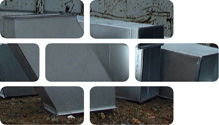![]()
Aluminium Metal 17 04 02
Aluminium is a silver grey metallic material that is lightweight and has a natural ability to resist corrosion. It is processed into sheet or block materials of varying thicknesses that are formed into a large range of products. Aluminium is rarely coated with paints and can be confused with galvanised or stainless steel. It is malleable to suit most architectural finishes.
Usage & Probable Locations
Aluminium is used as sheet materials, for roofing products, in studded walls, as casings for a wide range of electrical products, for window and door frames and for solar shading. It is also used in minor works as ironmongery, fixtures and fittings. It is located in service ducts, stud walls, cladding, roofs, rainwater goods and electrical equipment.
Personal Protective Equipment
PPE requirements indicated are for guidance purposes only. DRIDS has identified the PPE that is mandatory on all demolition projects and ones that may be required subject to site specific Risk Assessment & Method Statement (RAMS). Hover over the icon to determine the types of PPE required for the removal of this material.
Removal, Segregation & Storage
Aluminium that is destined for reuse should be deconstructed, segregated and stored carefully and safely. Roof sheets should be stored flat on a suitably sized pallet or in bundles to prevent creasing. They should also be stored away from plant movements to prevent damage. Aluminium destined for recycling should be segregated into metal recycling skips. There is little need to store aluminium inside a building or under cover as they are robust against inclement weather.
Tools
Fixtures, Fittings & Connections
Aluminium roof sheets are usually fixed in place with nails or screws and the joints sealed or compressed. Ironmongery are mostly screwed in place and rainwater goods laid on brackets and sealed at the collars. Aluminium ducting and pipework are fixed in place with brackets or hung from ceilings and generally bolted together. Aluminium casings for electrical goods are generally free-standing or screwed/bolted to other items. Aluminium studwork frames are riveted or screwed and covered in plasterboard or other sheet finish. Aluminium window and door frames will be fixed in place with screws or built-in to walls.
Health & Safety
Subject to task-specific Risk Assessment & Method Statement (RAMS). Use correct protective equipment for removing screws, nuts and brackets. Wear gloves when handling aluminium sheets with sharp edges or coated in plastic to prevent irritation, cuts and metal splinters. Wear eye protection when using abrasive cutting hand tools. Do not walk on wet roof sheets. Use harness protection at height. Only use cutting tools if properly trained.










